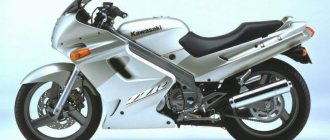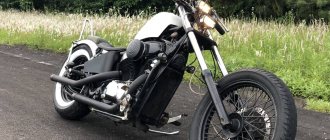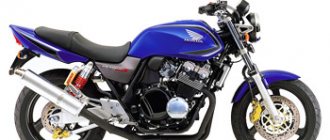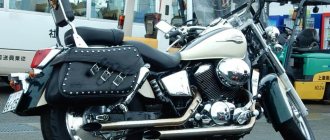Japanese motorcyclesHonda motorcycles
The longevity of a particular line of motorcycles largely depends on its popularity among consumers.
This trend is well revealed by the line of Japanese motorcycles Honda Shadow.
The origin of the Japanese “Shadow” line occurred in 1983, with the production of the 750 cc model Honda Shadow VT750c - a classic American style motorcycle.
And for more than 20 years, Shadow continues to be produced.
Over time, the line expanded, motorcycles with different technical characteristics were added, which ensured and continues to provide demand among a wide audience of two-wheeled transport enthusiasts, since everyone can choose a bike from this line to suit their taste.
Most of the models in this line are intended for American and European motorcycle enthusiasts, but the Japanese do not forget about themselves.
So, in 1999, they released the Honda Shadow Slasher 400 bike for their market.
Release Features
Thus, in 1997, in parallel with the “American shadow” (Shadow 750 ACE), a domestic Japanese version was produced - a smaller engine, power, worse dynamics, but at a very affordable price. Users who saw the new creation were delighted: “ Yes, this is a real liter, only less voracious .”
Since the documentation of the bikes went through the factories at the same time, they copied many details from each other. But there is one small detail due to which the motorcycles had different fates.
The production of the older one continues, but the younger one has been discontinued.
This is a prototype model. The younger one was planned to replace the Steed 400, and therefore took many parts from it.
The model existed until 2016 , receiving restyling in the same years as the older one.
Prices
The Tuesday market price for it starts at $3,000 . The price must include the cost of delivery from Japan and customs clearance. Since the model remained Japanese and at the same time production was gradually reduced, versions with mileage in the Russian Federation are not worth considering (editor’s opinion, that is, mine).
Specifications
Engine – left view.
Engine – right side view.
Cooling system radiator.
Crankcase.
Although the engines of the bikes are similar, the younger version received its version directly from Steed.
No changes, same compression ratio, torque, power. And also the absence of hydraulic gap compensators (which were used by the older model of those years).
| HONDA Shadow 400 | Parameter |
| Engine | 2-cylinder, 4-stroke liquid-cooled engine with V-shaped pistons (angle between cylinders - 90 degrees). SOHC, 3 valves per cylinder |
| Power | 31.0 - 33.0 hp |
| Dimensions (Length * Height * Saddle Height) | 2450 * 925 * 1085 mm |
| Ground clearance (distance to the lowest point) | 130 mm |
| Dry weight | 225 kg |
| Cooling system | liquid |
| Drive unit | chain (later cardan) |
| Transmission | 5-speed manual |
| Maximum speed | 145 km/h |
| Comfortable cruiser | 100 km/h |
| Acceleration up to 100 km/h | 11 sec |
| Gas tank volume | 14 l |
| Power reserve | ~ 280 km |
But on the other hand, the similarity of the bikes did not pass without a trace and the 400 gets a 2-cylinder, 4-stroke liquid-cooled engine with a V-shaped pistons arrangement (the angle between the cylinders is 900 ).
It is also worth noting that in 2008, both models have fuel injection .
Transmission and clutch
The first generations of the motorcycle were produced with a classic chain drive.
The story with the chassis of the motorcycle became interesting.
It is equipped with a 5-speed gearbox. Traditionally, it works great for Honda and does not create any problems for the user.
The motorcycle receives a main drive - a chain and a hydraulic clutch .
But in 2008 , with the next restyling of the line (according to some publications, the closure/opening of the old model in a new guise), they changed their systems. The new 750 gets a chain , the new 400 gets a driveshaft . The clutch drive is also changed - on the 400 a cable is installed.
Brakes
Front disc brake.
Rear drum brake.
Even if we assume that the model was closed/opened in 2008, this did not affect the brakes.
A drum was still placed on the rear axle, and a disc was placed on the front hub.
Rotor diameter 296 mm , supported by 2 pistons . The only tribute to restyling was the placement of the brake disc on the other (right) side.
No additional systems such as ABS are provided.
Description of design
The front wheel is covered on top by an oversized fender.
The front fork has widely spaced stays. It itself is covered with chrome. The front lighting equipment consists of a small headlight and two small turn signals. A wide handlebar is installed at the top of the front fork.
Behind the steering wheel there is a small teardrop-shaped tank with a dashboard mounted on it .
The seat is not particularly large, has a stepped shape, and is designed for two people.
The hind wing is wider than the front wing, but short. At its end there is a brake light, as well as a platform for the number.
The frame is tubular, practically invisible; the radiator of the cooling system is located in front of it.
The power plant is a V-shaped, 2-cylinder with a carburetor power supply system, integral with the gearbox. An air filter is installed on the right side between the cylinders.
There are two exhaust pipes, one for each cylinder, and are located on the right side.
Gearbox – foot-switched, 5-speed. Transmission of torque to the rear drive wheel using a chain drive.
The rear suspension is pendulum type using two shock absorbers installed on the sides.
Review of the super-heavy cruiser Honda Valkyrie F 6 C, the flagship of the Honda motorcycle industry.
We present you an overview of a budget motorcycle for everyday life:
Driving performance
Due to the production upgrade, the maximum speed increased slightly compared to the prototype - 145 km/h . However, the owners noted that this did not have the best effect on the dynamics.
Dynamics (overclocking)
The bike accelerates normally up to 100 km/h, but beyond that it is very sluggish and reluctant. Long overtaking is not recommended.
The 400 is certainly not a liter cruiser; it clearly lacks power on the highway.
A normal cruiser is 100 km/h.
Acceleration from zero to 100 km/h in 11 seconds . When compared with the prototype, users noted that it was almost identical, maybe a fraction of a second faster.
Fuel consumption
According to the manufacturer's documentation, consumption is 2.5 liters per 100 km before restyling in 2008, almost 3 liters after. But since the motorcycle is for the domestic market, the indicators are also indicated in an internal manner. Owners from the Russian Federation note an average consumption of 4.5 liters. A more accurate result depends on the traffic situation.
Provided that the tank is 14 liters , you can drive up to 200 km at one gas station, if “dry” - 280 km .
So my full first motorcycle season has ended, when you can ride according to the special regulations, you have a license and insurance. It was delayed for a long time, but this time it didn’t pass me by, and I drove in and out, fortunately, unharmed. In this post I would like to share my impressions of the season. I won’t write about the agony of choice; I’ve long wanted an “iron” cruiser or a retro classic. Based on the budget, I looked towards the Honda Shadow 400, Yamaha Dragstar 400, Honda VRX400 and Kawasaki W650. I've had my eye on Shadow for a long time. The circumstances turned out very well, and on the very first day of traveling through advertisements, my “Shadow” was found. The motorcycle turned out to be in good condition, completely stock, except for the Cobra exhaust with flutes, the sound is not very loud and is pleasant at low speeds. The motorcycle is full-size, the same as its older brother VT750, giving the impression of a large cruiser. Since most of the time I am busy in the office, and at home I have my family and my own worries waiting for me, the mileage for the season - like the length of the equator 40 thousand km - turned out to be quite small, the maximum speed was reached - the speed of light according to the speedometer.)) The motor was mainly used for walking weekends, small day trips around the city. For me, it is more like an outlet and a means to “clear my head” than a transport or means of transportation. At the beginning of the season, I stopped by the service center to check the condition, cleaned and lubricated the chain, changed the brake fluid, and adjusted the brakes and clutch. The condition turned out to be good, only tires needed to be replaced. The original Danlop 404 was cracked on the sides, and there was also decent wear on the front. I swapped the front one for a Metzeler 880 Marathon, I really liked it! In general, heaven and earth, I didn’t think that I would notice the difference, but there is a concrete difference! It feels like you're constantly on edge with old stock tires, as if you're walking in sneakers on ice. You don’t seem to be slipping, but it’s unpleasant to walk, and you think about every step. And on new tires you just sit down and drive calmly. Next season I plan to change the rear cylinder too, I hope that I will be able to buy the same one.
During the season I drove about 2.5-3 thousand km, all this time only gasoline flowed. By the way, I didn’t measure the consumption, but a 14 liter tank in city mode lasts a long time. I think that the consumption is no more than 4-4.5 liters per 100 km. I mostly rode around the city, and also went to the small satellite towns of Aramil, Polevskoy and Pervouralsk, all of which are not far from Yekaterinburg, so I managed to travel a little more than 100 km at a time (round trip). In the city there is enough dynamics, it accelerates faster than most cars. The steering wheel is too wide for the aisle, but after a month I got used to squeezing between the mirrors at an intersection. If I see that it’s narrow, I don’t climb. If it’s slow, but we’re going, then I’m going with everyone else. Still, this is not a 50 cc scooter that can fit into all the cracks.
The dynamics up to 80 km/h are quite good, after 80-100 you can sluggishly reach 120-130, but without a windshield it blows away a lot, and this is on the verge of possibilities. Once I managed to accelerate to 140 on the speedometer, but as an experiment, adequate speed was allowed by traffic rules. In my opinion, the most fun for him is 60-80 km/h; at 60 km/h you can drive around the city with an open visor, the exhaust rumble measuredly, and catch flies with a satisfied smile.)
I often went on the old Moscow highway, an excellent serpentine road all the way to Pervouralsk through the Europe-Asia monument (the Geographical sign “Europe-Asia” was installed in 1837 on the slope of Mount Berezovaya (413 km), the highest point of the Siberian highway, crossing the Ural Mountains with west to east. The Ural ridge is the main watershed, a natural border between two parts of the world, scientifically substantiated in the 18th century by the Russian historian and geographer V.N. Tatishchev). From time to time we rode with other bikepost members, and our social circle in the motorcycle community grew a little.
The front wing is in Europe, and the rear wing is in Asia!
Summer this year in Yekaterinburg almost slept through again, but in September there were sunny, warm days. Ever since school I hated the wet, nasty autumn with fallen leaves, but this year I saw it from the other side. When it’s +15...20 degrees outside, the air is fresh, you’re driving alone along the highway, bright yellow and red trees flash along the road, reflected with the blue sky in the chrome of the headlight... this is the kind of autumn you can love! And this is how I remember her.
I went to the official city closing of the motorcycle season. It was pouring rain, until the last minute I was thinking whether to go or not. Shortly before the start, the rain stopped and I decided to go. I met an acquaintance on Warrior, and we rode together in a convoy. We drove in a convoy through the city, then to Aramil to the Sputnik children's camp. I walked around there, looked around and drove back.
I found my “big brother.”
On October 11, I filled the tank full for the winter; I left the gas station and it began to snow. From the gas station to the garage about 200 meters, I carefully drove on the asphalt, freed up space, and parked the bike. I leave the garage - there is 8-10 centimeters of snow! I managed to do it right, as they say!)) For winter storage, I washed the motorcycle, filled the tank full, wrapped the exhaust with film and tape (so that no moisture got inside), removed and took the battery into a warm place. If possible, I would also like to change the oil and filter before winter so that it sits clean inside. Plans for the next season: changing the oil with filter, spark plugs and air filter, as well as rear tires. Well, buying at least the minimum equipment, taken care of - God protects. I hope that next season I will ride more, perhaps I will be able to go on a short distance.
Those who are still riding - be careful and vigilant, those who are wintering - be patient, those who closed the season ahead of schedule - get well, treat the horses and be back in the saddle for the next season! 
Modifications
Shadow 400 Slasher is a popular modification of the model.
Like the older version, the motorcycle is acquiring several modifications. The similarity of the “shadows” was evident even in the names of the variations.
- In 2000, the Shadow 400 Slasher appears (in the 750 Shadow Spirit or Shadow 750 Slasher for Japan).
- October 2008 is marked by a massive restyling of both lines. As a result, the Shadow 400 receives the Classic (the appearance becomes similar to the Shadow 750 Aero).
- The Slasher 400 becomes the Shadow 400 Custom (the 750 has a similar model, the VT750C2 Shadow Spirit).
and competitors
However, such a leapfrog of names did not prevent competitors from showing their answers to the 400.
- Kawasaki offered the VN 400 Vulcan.
- Yamaha one of its “shooting stars” XVS 400 Drag Star.
Suzuki has produced as many as 3 versions:
- Intruder VS400;
- Intruder VL400 Classic
- Desperado 400.
Brief history of the model
history of the model 1997 - the beginning of production and sales of the Honda Shadow 400. Model: Honda Shadow 400 (Japan). Frame number: NC34-100XXXX. Factory designation: NV400C2V.
1998 - no significant changes. Model: Honda Shadow 400 (Japan). Frame number: NC34-110XXXX. Factory designation: NV400C2W.
1999 - no significant changes. Model: Honda Shadow 400 (Japan). Frame number: NC34-120XXXX, NC34-125XXXX. Factory designation: NV400C2X, NV400CX.
2000 - appearance of the Honda Shadow 400 Slasher modification. Model: Honda Shadow 400; Honda Shadow 400 Slasher (Japan). Frame number: NC34-140XXXX; NC40-100~, NC40-110~. Factory designation: NV400C2; NV400DCy.
2001 - no significant changes. Model: Honda Shadow 400; Honda Shadow 400 Slasher (Japan). Frame number: NC34-150~; NC40-120~. Factory designation: NV400C21; NV400DC1.
2002 - no significant changes. Only the Slasher 400 version is temporarily produced. Model: Honda Shadow 400 Slasher (Japan). Frame number: NC40-130~. Factory designation: NV400DC2.
2003 - no significant changes. Only the regular version of the Shadow 400 is temporarily produced. Model: Honda Shadow 400 (Japan). Frame number: NC34-160~; NC34-230~. Factory designation: NV400C23; NV400C3.
2004 - no significant changes. Model: Honda Shadow 400; Honda Shadow 400 Slasher (Japan). Frame number: NC34-170~; NC40-140~. Factory designation: NV400C4; NV400DC4.
2005 - no significant changes. Model: Honda Shadow 400; Honda Shadow 400 Slasher (Japan). Frame number: NC34-180~; NC40-150~. Factory designation: NV400C5; NV400DC5.
2006 - no significant changes. Model: Honda Shadow 400; Honda Shadow 400 Slasher (Japan). Frame number: NC34-190~; NC40-160~. Factory designation: NV400C6; NV400DC6.
2007 - no significant changes. Model: Honda Shadow 400; Honda Shadow 400 Slasher (Japan). Frame number: NC34-400~; NC40-170~. Factory designation: NV400C7; NV400DC7.
2008 is the final year of release of the NV400 Shadow and NV400DC Slasher. Model: Honda Shadow 400; Honda Shadow 400 Slasher (Japan). Frame number: NC34-410~; NC40-180~. Factory designation: NV400C8; NV400DC8.
2009 (October 21, 2008) - new versions replace previous versions - Classic and Custom. The Honda Shadow 400 Classic differs from the previous version of the Honda Shadow 400 in the shape of the wings, split exhaust (2-into-2), the shape of the air filter cover, the brake disc on the right side, the injector, the cardan drive and a slightly narrower rear wheel (160 mm instead of 170 mm). The Honda Shadow 400 Custom version differs from the previous Slasher version by a 21′ front wheel (instead of 19′), the shape of the rear wing, the shape of the air filter cover, an injector, a driveshaft and a 14 liter fuel tank (instead of 13 liters). Also, new modifications received other gear ratios and other suspension settings. These models are positioned as 2009 motorcycles and have the factory code VT400 (instead of NV400). Model: Honda Shadow 400 Classic; Honda Shadow 400 Custom (Japan). Frame number: NC44-100~; NC45-100~. Factory designation: VT400C9, VT400CA9; VT400C29, VT400C2F9.
2010 - appearance of the Honda VT400S modification. Model: Honda Shadow 400 Classic; Honda Shadow 400 Custom; Honda VT400S (Japan). Frame number: NC44-100~; NC45-100~; NC46-100~. Factory designation: VT400C9, VT400CA9; VT400C29, VT400C2F9; VT400S.
2011 - no significant changes. Model: Honda Shadow 400 Classic; Honda Shadow 400 Custom; Honda VT400S (Japan). Frame number: NC44-100~; NC45-100~; NC46-100~. Factory designation: VT400C9, VT400CA9; VT400C29, VT400C2F9; VT400S.
2012 - no significant changes. Model: Honda Shadow 400 Classic; Honda Shadow 400 Custom; Honda VT400S (Japan). Frame number: NC44-100~; NC45-100~; NC46-100~. Factory designation: VT400C9, VT400CA9; VT400C29, VT400C2F9; VT400S.
2013 - no significant changes. Model: Honda Shadow 400 Classic; Honda Shadow 400 Custom; Honda VT400S (Japan). Frame number: NC44-100~; NC45-100~; NC46-100~. Factory designation: VT400C9, VT400CA9; VT400C29, VT400C2F9; VT400S.
2014 - no significant changes. The last year of production of the VT400S and Custom modifications. Model: Honda Shadow 400 Classic; Honda Shadow 400 Custom; Honda VT400S (Japan). Frame number: NC44-100~; NC45-100~; NC46-100~. Factory designation: VT400C9, VT400CA9; VT400C29, VT400C2F9; VT400S.
2015 - no significant changes. Model: Honda Shadow 400 Classic (Japan). Frame number: NC44-100~. Factory designation: VT400C9, VT400CA9.
2016 is the last year of release of the Classic modification. Model: Honda Shadow 400 Classic (Japan). Frame number: NC44-100~. Factory designation: VT400C9, VT400CA9
Features of HONDA Shadow 400
In terms of its parameters and appearance, the HONDA Shadow 400 is a typical classic cruiser.
Apart from interesting decisions regarding changing the chassis, the bike has few differences.
- Suspension with short travel , which cannot be adjusted.
- 2 springs on the rear shock absorber provide a soft ride, but they also make their way with a bang even with a small load (it’s better not for two burly men to sit on this bike together).
- A motorcycle for the city - it’s better not to meddle with the Moscow Ring Road with its flow speeds.
- The chopper seat allows you to change the position of your legs when driving, and the soft sofa allows you to cover significant distances in “one sitting.”
Users note a number of other characteristics, but all of them confirm the version of the motorcycle for the city.










